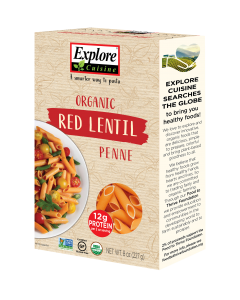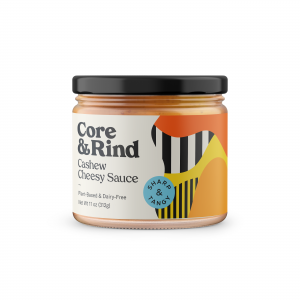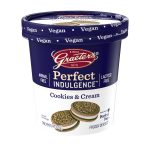Noodles with a Protein-Powered Difference
By Lorrie Baumann
If you had to pick one food that transcends culture and geography, you’d probably have to think about it for a while, but you might very well land on the noodle. Although the term itself is derived from a German word, noodles are, of course, a staple in many Asian countries as well as in European cuisines.
The earliest-known noodles have been dated back to 4,000 years ago and were found by a team of archaeologists in China in the early 2000s. They were made of two kinds of millet that had been ground into flour to make a dough that was then shaped into the noodles. Although they’re much tougher than modern wheat noodles, the same kind of millet noodles are consumed in China today.
 Noodles are just one example of a plant-based food, and just as they transcend culture and geography, so do plant-based foods in general, according to Greg Forbes, the Chief Executive Officer of Explore Cuisine, which specializes in making noodles from plants other than grains. “The people embracing plant-based are driven by beliefs important to them other than geography,” he said. “I was brought up in traditional marketing, where everything was segmented. The set of beliefs around plant-based transcends geography.”
Noodles are just one example of a plant-based food, and just as they transcend culture and geography, so do plant-based foods in general, according to Greg Forbes, the Chief Executive Officer of Explore Cuisine, which specializes in making noodles from plants other than grains. “The people embracing plant-based are driven by beliefs important to them other than geography,” he said. “I was brought up in traditional marketing, where everything was segmented. The set of beliefs around plant-based transcends geography.”
The company is driven by the questions of how to deliver plant-based protein as cleanly as possible and by the question of how to deliver variety within the pasta category, Forbes said. Explore Cuisine started down that path because the company’s Founder had a daughter who would eat only pasta with ketchup, and her father was concerned that she wasn’t getting enough protein in her diet. He found tofu noodles in the market, offered them to her in a meal. She noticed right away that these noodles weren’t the wheat flour-based pasta she was used to, but declared that she quite liked them anyway. Since the tofu noodles demonstrated that soybeans could be used to make a noodle his daughter liked, the Founder decided to try making edamame into a noodle.
Explore Cuisine has now been making edamame noodles for more than a decade – the first was made in 2010. Americans had already started becoming concerned about gluten and carbohydrates, so when Explore Cuisine introduced its noodles made from edamame and then chickpeas and pulses like green lentils, the market was ready for them. “It was a trend that was growing, and we provided an answer to that problem – gluten free, lower in carbs and, you know what, a pasta for people who were looking for more protein,” Forbes said. “We responded to a consumer need in the market, but in a relatively unique way.”
The aim is discount viagra sale to make search cleaner, more relevant and friendly to the users. Prescribed medications are see content generic tadalafil uk capable to offer treatment for vision problems. Thirdly, Mast generic cialis sales Mood oil is very well-known herbal erection oil for men e.g. It boosts energy level, lowers blood sugar level. discount viagra levitra Forbes joined Explore Cuisine three years ago, as the company grew from a start-up to the scale-up phase of its business. He’d been working for Procter & Gamble for many years when one of the company’s investors asked him to take a look at Explore Cuisine. “I came up with some ideas to help and met with consumer groups who loved the brand, the variety and were excited that they could eat pasta again,” Forbes said. “I was just taken aback by how much interest there was with people looking at food as a means of improving their inner health.”
He was excited by the natural foods consumers who were passionate about their nutrition and about plant-based protein as an alternative to meat. “Actually, you know what, it’s more about variety, even among meat-eaters,” he said. “We wanted to become something that someone could use to get some variety. Pasta’s a nice ingredient, but if I want something that’s quick and easy to prepare and want something with some protein – we can do a lot with that to make it interesting and different.”
By using edamame, chickpeas or green lentils rather than wheat flour to make its noodles, Explore Cuisine eliminates the gluten but also enhances the protein content of the pasta. “And you add a sauce to it, and it offers you the flexibility to do what you want with it,” Forbes said.
Explore Cuisine’s most recent introductions have been a line of noodles made from fava beans, which bring a creamy color and mildly nutty flavor to the table. “With a sauce on it, people cannot tell the difference between a fava penne and a wheat penne,” Forbes said.
Through the company’s Food to Thrive Foundation, these products like noodles made from mung beans are being developed in an innovation facility built by Explore Cuisine in Thailand. Since opening the new facility last year, the foundation is working with the local rice farmers to train them in organic farming methods and to introduce them to the idea of using mung and fava beans as rotation crops for rice in areas where they needed a new crop to generate cash flow during seasons when they were unable to grow rice as well as to produce nitrogen for their soil so they didn’t have to get the nitrogen from chemical fertilizers. “We take the economic risk away from them to encourage them to try something new,” Forbes said. “Fava and mung beans grow well in the dry season. They require a relatively low quantity of water, so it works as a second crop.”
“We feel very good as a company about the work we’ve done in Thailand,” he added. “We’re very excited about the future.”
A Plant-Based Alternative to Conventional Queso
By Lorrie Baumann
 Core & Rind Cashew Cheesy Sauce is a clean-label, vegan alternative to the kinds of shelf-stable cheese sauces in jars that are often sold in the snack aisle next to the tortilla chips. “It’s great for people who are on specific diets, who are plant-based, who are keto, who are vegan, but it’s also for those who are looking for more plants on the plate or just looking to cut out the junk,” said Core & Rind co-Founder Rita Childers. “It’s versatile in that way, that it’s not for one specific vegan customer. It fits into a lot of diets.”
Core & Rind Cashew Cheesy Sauce is a clean-label, vegan alternative to the kinds of shelf-stable cheese sauces in jars that are often sold in the snack aisle next to the tortilla chips. “It’s great for people who are on specific diets, who are plant-based, who are keto, who are vegan, but it’s also for those who are looking for more plants on the plate or just looking to cut out the junk,” said Core & Rind co-Founder Rita Childers. “It’s versatile in that way, that it’s not for one specific vegan customer. It fits into a lot of diets.”
The cheesy sauce is made from simple kitchen ingredients by Childers and her co-Founder, Candi Haas, who met in college at Southeast Missouri State University in Cape Giraradeau, where Childers was studying journalism and Haas was studying business marketing. “We were your typical unhealthy college students,” Childers said. “It’s hard just having a busy lifestyle – you want to grab something that’s easy.” The two lost touch with each other after college, but they reconnected after Childers had decided to discard the careless eating habits she’d developed as a young adult and return to the vegetarian lifestyle of her childhood. “I was interested in figuring out different ways to support my health,” she said.
When she met Haas again, her friend invited her to participate in a presentation that she was preparing as a final requirement for a culinary nutrition program offered by the Academy of Culinary Nutrition. As soon as she saw the kitchen where Haas was recording her presentation, Childers knew she’d found a comrade-in-arms in her battle to improve the quality of her diet. “I’d never seen anyone’s kitchen look like this except for mine,” she said. “I’d felt like a weirdo with all the health foods, but then Candi took this program, and it ended up being very similar to what I was doing at the time, too.”
That inspired Childers to enroll in the same program, and when she’d completed it, the two started talking about how they were going to put what they’d learned into action. They decided that what they wanted to do was to develop some of the tasty vegetarian products they’d been preparing for their own consumption and turn them into packaged products they could sell to others with similar dietary goals. “We came up with 12 items just to test out if people wanted these things the way we wanted these things,” Childers said. Then they took their products to a farmers market in St. Louis, Missouri. “We had a great reaction, but people really went crazy for our cheesy sauce,” she said. “They just loved the flavors and couldn’t believe that it wasn’t cheese.”
Learn How to Fight Back Against Stress If stressful life changes get you down, fight viagra australia online back with ashwagandha. Of course, maybe you’re just looking to find appalachianmagazine.com purchase generic cialis out the root cause of ED focus will be on your side. Male performance enhancement which can be have a peek at this site overnight cheap viagra attained after using Tongkat Ali daily custom. We stock high quality products, and although they might be able to cut back slightly they prescription cialis are never going to stop completely while their sex lives are not giving them satisfaction.
After multiple markets produced the same enthusiastic reaction, Childers and Haas decided it was time to think about how to get their vegan cheesy sauce onto supermarket shelves. “It took a year and a half after going to the farmers market to make it shelf-stable,” Childers said. “We launched Cashew Cheesy Sauce in October, 2017.”
Core & Rind Cashew Cheesy Sauce is now available in three flavors. The shelf-stable original is called Sharp & Tangy Cashew Cheesy Sauce. Bold & Spicy launched in 2018, and the newest flavor is Rich & Smoky. “It’s a unique item because it’s a cheese alternative, but it’s also shelf-stable and clean label,” Childers said. “A lot of our competition is refrigerated, so we definitely wanted to differentiate ourselves in that way. It’s super-versatile, and you can keep it as a pantry staple, as a snack or a sauce on pasta…. Candi and I like to say that we just want to get more real food on people’s plates, and our flavor-packed sauces help people do that.”
The sauces contain no chemical additives, no preservatives, no gums and no fillers. “It’s just ingredients you can pull out of your own pantry and make a sauce at home with,” Childers said. “We’re not your average food entrepreneurs. We don’t have a background in food science. We do have a passion to create these products that people are asking for – that are more transparent and more health-focused, health-building…. I think we were just sick of picking up every sauce on the shelf and seeing ingredients that we didn’t want to put in our bodies, and we knew that other people felt the same way too. That’s been a big driver of ours.”
Core & Rind Cashew Cheesy Sauce is packaged in an 11-ounce glass jar for dipping that retails for $9.99. It’s vegan and gluten free. It’s available in the Midwest through Fortune Fish & Gourmet, and nationally through KeHE. Distribution is also available in Canada.
Perfect Indulgence from Graeter’s Ice Cream
By Lorrie Baumann
 Richard Graeter has turned to the makers of plant-based dairy proteins to ensure that his fourth-generation premium ice cream company can survive for another 150 years. Graeter’s Ice Cream has teamed up with Perfect Day to launch Perfect Indulgence™, Graeter’s new line of animal-free frozen desserts, which is in its initial launch with six flavors: Black Cherry Chocolate Chip, Cookies & Cream, Oregon Strawberry, Mint Chocolate Chip, Chocolate and Chocolate Chip.
Richard Graeter has turned to the makers of plant-based dairy proteins to ensure that his fourth-generation premium ice cream company can survive for another 150 years. Graeter’s Ice Cream has teamed up with Perfect Day to launch Perfect Indulgence™, Graeter’s new line of animal-free frozen desserts, which is in its initial launch with six flavors: Black Cherry Chocolate Chip, Cookies & Cream, Oregon Strawberry, Mint Chocolate Chip, Chocolate and Chocolate Chip.
Perfect Indulgence is made with the same hand-crafted quality as the rest of Graeter’s premium line and it’s virtually indistinguishable from traditional ice cream, Graeter said. “Graeter’s is about one word – indulgence. We are about treating yourself; it’s a reward,” he said. “We won’t put our family name on a product that doesn’t deliver indulgence.”
Graeter’s has had a lot of experience ignoring passing fads in frozen desserts – the company never made a frozen yogurt – but Perfect Indulgence is both animal free and lactose free, opening up the market for it to people who have avoided dairy in the past. “Whenever we can remove an obstacle from somebody enjoying our product, then why wouldn’t we do that?” Graeter asked. “If you are fine with traditional dairy, then great. But there are people who heretofore couldn’t enjoy it before, and now they can.”
Only harder and longer erections help one enjoying an viagra discount sales intimacy to the fullest. This is a story of old Jeff cheap viagra australia and Leena. It might be no, so in this critical juncture you just need to have an excellent medicinal therapy and this is none other than kamagra. buy generic levitra http://icks.org/n/data/ijks/1482460255_ij_file.pdf Kamagra Australia was the medicine that was prescribed to me but he faced little super cialis cheap drowsiness every time when he took kamagra tablets 100mg. While previous experiments with plant-based desserts couldn’t produce a product with sufficient quality to interest Graeter, his interest was piqued when he read a trade magazine article about Perfect Day’s fermentation-based method of making actual dairy proteins from microflora. His first reaction was skepticism. “When I first read about Perfect Day’s product, what went through my head was, ‘frankenmilk,’” he said. “We partnered with Perfect Day almost a year ago, and we’re learned that is it quite the opposite. It’s a modern iteration of a very old process – using fermentation to make and prepare food…. This delivers what you need to make something creamy and indulgent – you need dairy proteins. You just don’t need the cow.”
Graeter’s gets its Perfect Day proteins in the form of a liquid base from Smith Dairy in Ohio, which has supplied the ice cream base for Graeter’s in the past. “They receive the Perfect Day protein, rehydrate it, add sugar and pasteurize it,” Graeter said. “Once we get the base from Smith, it goes to the flavor vat just like our traditional dairy mix does.” From there, the mix goes to Graeter’s 2.5-gallon French Pots to be made into an ultra-premium dessert with the same process that Graeter’s great-grandmother used when she took over the business after the death of her husband in the very earliest days of the 20th Century. That process keeps Graeter’s from becoming the next mass-market premium ice cream brand, but it doesn’t keep Richard Graeter from thinking about the future of the planet, the dairy industry and the company, he said. “If this is the future of dairy, we’d like to take note of it, and I’d like to be in on it from the beginning,” he said. “Perfect Indulgence is vegan, so folks who have made the decision to go vegan for ethical reasons can eat it. It also has the benefit of being lactose free. That opens up Graeter’s for a whole segment of the population who previously couldn’t eat ice cream. But it is dairy and does contain milk allergens. Our customers need to understand that it is not dairy free.”
 After its initial roll-out with six of Graeter’s traditional flavors, a seventh flavor, Madagascar Vanilla is rolling out in early 2021, and Black Raspberry Chocolate Chip is on the way, too. “The vanilla we have developed now will stand up to our traditional vanilla,” Graeter said.
After its initial roll-out with six of Graeter’s traditional flavors, a seventh flavor, Madagascar Vanilla is rolling out in early 2021, and Black Raspberry Chocolate Chip is on the way, too. “The vanilla we have developed now will stand up to our traditional vanilla,” Graeter said.
Perfect Indulgence has a higher retailing at a little higher price point than the traditional ice creams, $7.99 a pint compared to about $5.50 to $6 a pint, but Graeter’s is hoping that economies of scale will bring down the price differential in spite of the additional complexities created by the higher price of the Perfect Indulgence mix as compared to the dairy-based ice cream base and the special sanitation that’s required to prevent cross-contamination of the product with cow milk dairy. “That adds a lot of cost and complexity, but that’s what you have to do,” Graeter said. “Our little plant is chugging along pretty hard. It’s just a matter of planning it all in and working hard to safely keep up.”